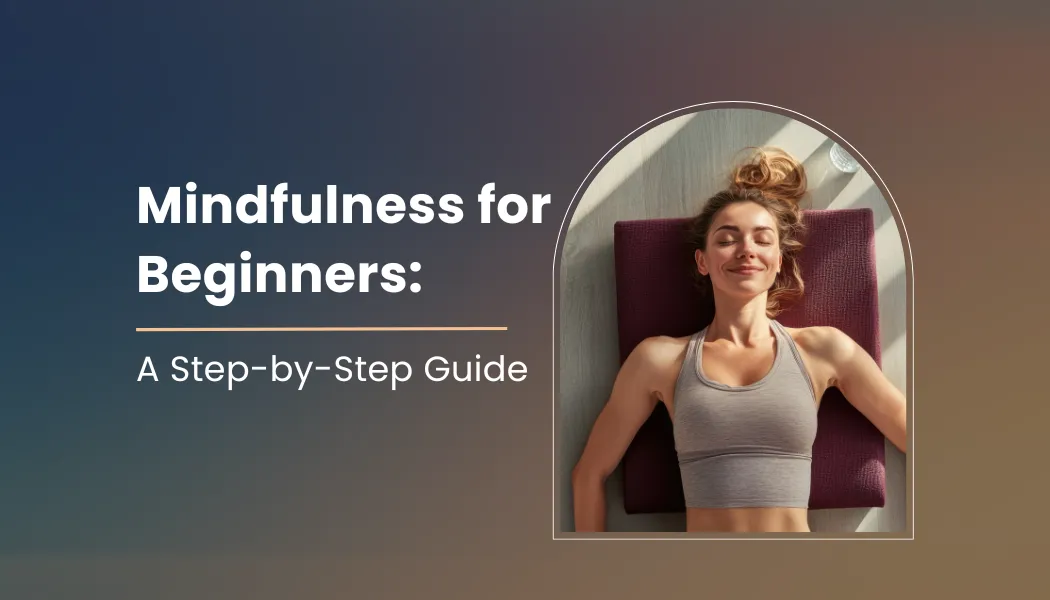Have you ever caught yourself rushing through your day — eating without tasting, walking without noticing, or scrolling through your phone without realizing how much time has passed?
You’re not alone. Most of us live in “autopilot mode,” lost in thoughts about the past or worries about the future. But there’s a simple, life-changing practice that can bring you back to the present moment — mindfulness.
Mindfulness isn’t about emptying your mind or achieving instant calm. It’s about learning to see clearly. It’s noticing what’s happening — your thoughts, feelings, sensations, and surroundings — without judging any of it as good or bad.
If you’re new to mindfulness, this guide will walk you through everything you need to know — what mindfulness really means, how to practice it step-by-step, and how to bring its peaceful awareness into your daily life.
Let’s begin your journey toward presence and peace.
Table of contents
- What Is Mindfulness?
- Why Mindfulness Matters
- Step 1: Start with Your Breath
- Step 2: Notice Your Thoughts (Without Getting Caught in Them)
- Step 3: Practice Mindful Observation
- Step 4: Be Mindful While You Eat
- Step 5: Take a Mindful Walk
- Step 6: Check In With Yourself During the Day
- Step 7: Practice Loving-Kindness Meditation
- Step 8: End Your Day with a Body Scan
- Step 9: Bring Mindfulness into Everyday Life
- Step 10: Be Patient with Yourself
- The Science Behind Mindfulness
- Common Challenges for Beginners (and How to Overcome Them)
- Bringing It All Together
- Final Thoughts: Begin Where You Are
What Is Mindfulness?
Mindfulness simply means paying attention, on purpose, in the present moment, without judgment.
It’s the art of being fully aware of where you are and what you’re doing — instead of being lost in thought or reacting automatically.
Imagine your mind as a lake. On windy days, the surface ripples and you can’t see through. But when the wind calms, the water becomes clear, and you can see everything beneath.
Mindfulness helps calm that inner “wind,” allowing you to see life as it really is — not as your fears or expectations paint it.
Mindfulness can be practiced in many forms — through breathing, eating, walking, or simply noticing what’s happening right now. You don’t have to sit cross-legged or meditate for hours. You just have to be here.
Why Mindfulness Matters
Before diving into how to practice, it’s helpful to understand why mindfulness is so powerful. Science and ancient wisdom both agree: mindfulness changes how we live, think, and feel.
Here’s what it can do for you:
- Reduces stress and anxiety: By calming the nervous system and lowering cortisol levels.
- Improves emotional balance: You respond thoughtfully instead of reacting impulsively.
- Increases focus and clarity: You train your mind to stay with what matters.
- Enhances sleep and relaxation: Mindful breathing and awareness promote rest.
- Strengthens relationships: You listen and connect with genuine presence.
- Boosts overall well-being: It cultivates gratitude, patience, and compassion.
Mindfulness doesn’t erase life’s challenges — it helps you meet them with clarity and calm.
Step 1: Start with Your Breath
Your breath is your anchor. It’s always with you — a doorway back to the present.
How to Practice:
- Sit or stand comfortably.
- Close your eyes if you’d like.
- Take a deep breath in through your nose, feeling your chest and belly expand.
- Slowly exhale through your mouth.
- Repeat this for a few minutes.
Each time your mind drifts, gently bring your attention back to your breath — not with frustration, but kindness.
Why It Works:
Breathing mindfully activates the body’s relaxation response. It signals to your brain: You’re safe. Even one minute of mindful breathing can lower tension and reset your focus.
Try This: Take three slow breaths before answering a call or sending a message. It’s a small pause that brings big presence.
Step 2: Notice Your Thoughts (Without Getting Caught in Them)
One of the biggest misconceptions about mindfulness is that you must “stop thinking.” That’s impossible! The mind’s nature is to think — mindfulness simply helps you see those thoughts without being swept away.

How to Practice:
- Sit quietly and focus on your breath.
- As thoughts appear, notice them: “Ah, here’s a worry,” or “There’s planning.”
- Don’t fight them or follow them. Just observe.
- Imagine each thought floating by like a cloud in the sky.
Why It Works:
This trains you to create space between you and your thoughts. Instead of believing every thought is true or urgent, you start to see them as passing events — like weather.
Try This: When you feel anxious, pause and label your thoughts: “Thinking,” “Remembering,” or “Judging.” Naming them helps you detach gently.
Step 3: Practice Mindful Observation
Mindfulness is not just an internal experience — it’s about awakening your senses to the world around you.
How to Practice:
- Choose one object nearby — a leaf, a cup, a candle flame.
- Observe it carefully. Notice its color, texture, shape, and even the light reflecting off it.
- Notice any thoughts or feelings that arise.
- Stay present for one to two minutes.
Why It Works:
Mindful observation slows down your busy mind and brings you into direct contact with the beauty of the ordinary.
Try This: When waiting in line or during your commute, pick something in your surroundings to observe mindfully.
Step 4: Be Mindful While You Eat
Eating is one of the easiest (and most rewarding) ways to practice mindfulness.
How to Practice:
- Take a moment before your meal to pause and appreciate your food.
- Notice the colors, smells, and textures.
- Take your first bite slowly. Chew and taste fully.
- Put your utensil down between bites.
Why It Works:
Eating mindfully helps you reconnect with your body’s hunger and fullness cues. It also makes meals more enjoyable — turning an ordinary act into a moment of gratitude and calm.
Try This: Choose one meal per day to eat mindfully, even if it’s just a snack or cup of tea.
Step 5: Take a Mindful Walk
Walking can be meditation in motion. Each step becomes a rhythm of awareness.
How to Practice:
- Walk slowly and deliberately.
- Feel your feet touching the ground.
- Notice your breath matching your pace.
- Observe the sights, sounds, and sensations around you.
Why It Works:
Mindful walking grounds you in your body and environment. It turns an everyday routine into a moving meditation.
Try This: During a short break, take a five-minute mindful walk without your phone — just you and your steps.
Step 6: Check In With Yourself During the Day
Mindfulness is not just a morning or evening ritual — it’s a continuous invitation to check in.

How to Practice:
Set small reminders to pause and ask:
- What am I feeling right now?
- Where is my breath?
- What’s happening in my body?
You can do this in line at the store, in traffic, or between emails.
Why It Works:
Checking in helps you catch stress before it builds up. It’s like emotional maintenance — small tune-ups throughout your day keep your mind balanced.
Try This: Link your check-ins to daily triggers — like opening your laptop, drinking water, or walking through a doorway.
Step 7: Practice Loving-Kindness Meditation
Mindfulness is not just awareness — it’s kind awareness. Loving-kindness, or “metta,” helps you soften judgment toward yourself and others.
How to Practice:
- Sit comfortably and close your eyes.
- Silently repeat:
- “May I be calm.”
- “May I be healthy.”
- “May I be happy.”
- “May I live with ease.”
- Extend these wishes to others — loved ones, acquaintances, even people you find difficult.
Why It Works:
This practice opens the heart, reduces resentment, and builds compassion. It reminds you that mindfulness is not only for peace of mind — it’s also for peace with others.
Try This: Each night, send one kind wish to yourself and one to someone else.
Step 8: End Your Day with a Body Scan
Before bed, use mindfulness to release the tension your body has held all day.
How to Practice:
- Lie down and close your eyes.
- Bring attention to your toes. Notice any sensations.
- Slowly move up through your legs, hips, abdomen, chest, arms, and face.
- Breathe into areas of tension, imagining them softening with each exhale.
Why It Works:
The body scan promotes deep relaxation and awareness. It helps you reconnect with your body before rest — a mindful goodnight ritual.
Try This: Spend five minutes scanning your body before sleep instead of checking your phone.
Step 9: Bring Mindfulness into Everyday Life
You don’t have to carve out special time to practice mindfulness. You can weave it into what you already do:
- While brushing your teeth: Feel the bristles, taste the toothpaste, hear the sound.
- While driving: Focus on your hands on the wheel, your breath, and the scenery.
- While washing dishes: Notice the water’s temperature, the soap’s texture, the rhythm of your hands.
- While talking: Listen fully, without preparing your next response.
Every ordinary task can become extraordinary when done with awareness.
Step 10: Be Patient with Yourself
Like any skill, mindfulness takes time. Some days you’ll feel calm and focused; other days, distracted and restless. That’s okay.

Mindfulness isn’t about doing it perfectly — it’s about noticing when you’ve drifted and gently coming back.
Each time you return to the present, you strengthen your mindfulness “muscle.” With time, that awareness spills into every area of life — work, relationships, and even moments of silence.
Remember: Progress in mindfulness is not measured by stillness but by kindness.
The Science Behind Mindfulness
Thousands of studies confirm the benefits of mindfulness. Here’s what researchers have found:
- It lowers cortisol (the stress hormone) and improves heart health.
- It strengthens the prefrontal cortex — the part of the brain responsible for decision-making and self-control.
- It increases gray matter in areas related to empathy and memory.
- It helps manage chronic pain, depression, and anxiety.
- It promotes emotional intelligence and better focus at work or school.
Mindfulness isn’t a fad — it’s a proven practice that transforms how your brain responds to life.
Common Challenges for Beginners (and How to Overcome Them)
1. “I can’t stop thinking.”
You’re not supposed to. Thoughts will come — just watch them pass.
2. “I don’t have time.”
Start with one minute. You can practice mindfulness anytime — while breathing, walking, or even waiting for your coffee.
3. “I’m not doing it right.”
There’s no wrong way to be aware. Every moment of noticing is progress.
4. “I keep forgetting.”
Set gentle reminders — a bracelet, a note, or a daily alarm that says “Pause. Breathe. Be.”
Bringing It All Together
Mindfulness is not a quick fix — it’s a quiet revolution within yourself. The more you practice, the more natural it becomes to live with awareness instead of anxiety, with intention instead of impulse.
You’ll notice you become calmer, kinder, and more present in your own life. You’ll start to find beauty in small things — sunlight on your hands, laughter, or the simple joy of breathing.
When you practice mindfulness, you’re not escaping reality — you’re awakening to it.
Final Thoughts: Begin Where You Are
You don’t need special tools or perfect peace to begin. You only need a moment — this moment.
So take a slow, deep breath right now. Feel the air entering and leaving your body. Let that be your beginning.
Mindfulness isn’t somewhere you arrive — it’s something you live. And every breath, every step, and every act of awareness is a reminder that you are here, now.
